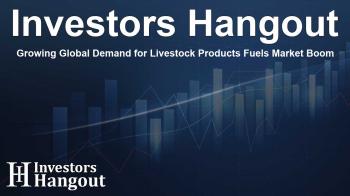Growing Global Demand for Livestock Products Fuels Market Boom

Overview of the Commercial Livestock Supplies Market
The commercial livestock supplies market is on the rise, expected to grow consistently due to increasing global demand for animal protein and the expansion of intensive livestock farming practices. As livestock producers focus more on animal health and productivity, advancements in feed technology, veterinary care, and automated farming solutions are becoming vital for sustained market growth.
Market Dynamics and Anticipated Growth
Allied Market Research indicates that the commercial livestock supplies market was valued at approximately $447.2 billion around 2024 and is projected to reach $671.2 billion by the end of 2034, representing a CAGR of 4.1%. Factors driving this increase include the surge in demand for animal-based food products and heightened awareness of animal welfare. This growing emphasis not only supports efficiency but also ensures high-quality livestock supplies.
Market Segmentation
The commercial livestock supplies encompass various products crucial for managing farm animals like cattle, poultry, sheep, and swine. Essential supplies include compound feeds, nutritional supplements, veterinary pharmaceuticals, and management equipment necessary for ensuring livestock receive adequate care and nutrition.
This market can be categorized by type – including roughages, concentrates, compound feeds, and feed supplements. Furthermore, categorizing livestock includes segments for cattle, poultry, swine, goats/sheep, and aquatic animals, with each segment contributing differently to the overall market dynamics.
Key Market Drivers and Opportunities
Growth in awareness about the importance of animal nutrition and welfare has notably influenced the commercial livestock supplies landscape, prompting producers to revolve their strategies around scientifically crafted feed and health products. This shift is essential for improving overall animal performance and adhering to production standards.
Additionally, the rising preference for high-yield livestock breeds has pushed the needs for advanced feeding solutions, reproductive aids, and veterinary care. Suppliers are responding to this heightened demand by introducing specialized products that cater to intensive farming operations, which require reliable, high-quality inputs.
Challenges Facing the Industry
Despite positive growth prospects, the commercial livestock supplies industry faces challenges, including feed price volatility that threatens profitability and restricts producers' ability to invest in necessary supplies. Additionally, environmental regulations concerning livestock farming may deter investment and market growth.
To counteract these hurdles, producers are encouraged to leverage feed optimization technologies and diversify raw material sources. Government involvement through subsidies and initiatives aimed at stabilizing the market can also play a significant role in enhancing the operational capabilities of livestock suppliers.
Regional Insights into Market Trends
The North American market thrives due to a well-established demand for high-quality animal protein and intensive farming methodologies. Producers are increasingly adopting precision livestock management tools and advanced feed formulations. However, the region must also navigate regulatory challenges concerning antibiotic usage and the financial implications of compliance.
In Europe, the drive for traceable, welfare-compliant animal products is influencing market development, with robust policies fostering the adoption of organic feed and sustainable farming solutions. Emerging market opportunities include plant-based feed innovations and smart farming technologies that align with European sustainability goals.
Asia-Pacific markets are rapidly evolving, spurred by demographic shifts, rising incomes, and increased meat consumption. Countries like China and India are particularly noteworthy for their expansion in poultry and swine sectors, driving demand for effective livestock management solutions.
Furthermore, the LAMEA region is experiencing growth due to urbanization and an increasing appetite for protein-rich diets. However, infrastructural challenges and environmental concerns could impact the pace of growth in commercial livestock supplies.
Frequently Asked Questions
What is the projected growth of the commercial livestock supplies market?
The market is anticipated to grow from $447.2 billion in 2024 to $671.2 billion by 2034, at a 4.1% CAGR.
What are the main drivers for the livestock supplies market?
Key drivers include rising global demand for animal protein, advancements in livestock health and productivity, and the expansion of intensive farming practices.
How is the market segmented?
The market is segmented by type (feeds and supplements) and by livestock category, which includes cattle, poultry, swine, and others.
What challenges does the industry face?
Challenges include feed price volatility, environmental regulations, and compliance costs, which can limit investment in livestock supply products.
Which regions are driving the most demand?
North America, Europe, and Asia-Pacific are key regions with significant demand due to varying market dynamics such as consumer preferences and regulatory environments.
About The Author
Contact Lucas Young privately here. Or send an email with ATTN: Lucas Young as the subject to contact@investorshangout.com.
About Investors Hangout
Investors Hangout is a leading online stock forum for financial discussion and learning, offering a wide range of free tools and resources. It draws in traders of all levels, who exchange market knowledge, investigate trading tactics, and keep an eye on industry developments in real time. Featuring financial articles, stock message boards, quotes, charts, company profiles, and live news updates. Through cooperative learning and a wealth of informational resources, it helps users from novices creating their first portfolios to experts honing their techniques. Join Investors Hangout today: https://investorshangout.com/
The content of this article is based on factual, publicly available information and does not represent legal, financial, or investment advice. Investors Hangout does not offer financial advice, and the author is not a licensed financial advisor. Consult a qualified advisor before making any financial or investment decisions based on this article. This article should not be considered advice to purchase, sell, or hold any securities or other investments. If any of the material provided here is inaccurate, please contact us for corrections.

